Solar Eclipse! Totally Awesome!
(© Photo Montage of the Eclipse by Jerry Black)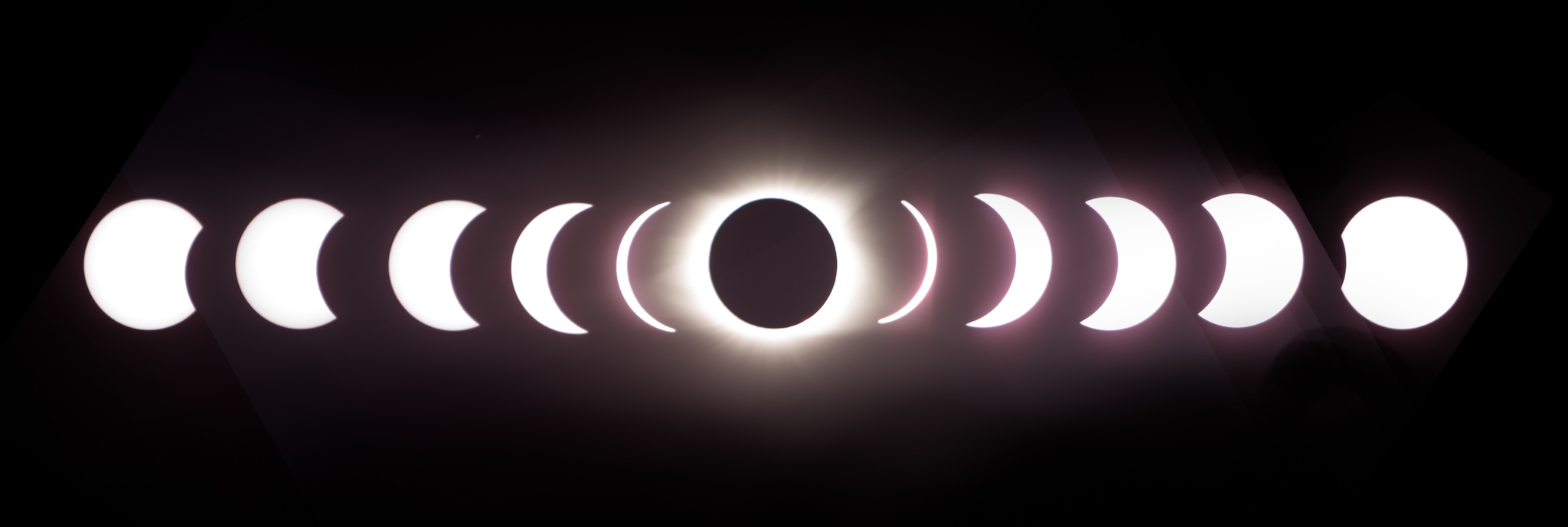
Location: Lingley, Wyoming
Date: 2017-08-21
Time: 10:30 AM - 1: 15 PM
Equipment: Visual + Binoculars 10x30 IS
Transparency: not recorded
Seeing: not recorded
How far will one travel to see a solar eclipse for the first time in their life? Does 4,393 km (2,739.7 miles) - one way - sound a bit far? Having just experienced my first solar eclipse, I can unequivocally say NO!
The planning of this trip began a year ago when Paul Gray had announced at a RASC Halifax Centre meeting that he had the perfect spot to view the eclipse - from the KOA in Grand Island, Nebraska. KOA reservations made last fall - check. Plan remainder of the 2.5-week trip to and from this exciting event - check. So, let's now focus on the experience in Nebraska. I remembered Roy’s cautionary note about experiencing the eclipse versus taking pictures. Consequently, I dictated notes to my phone so that my eyes didn’t have to leave what I was seeing for more than a split second.
The evening before the eclipse, there was a gathering of astronomers to determine the plan of attack for the next day based on weather reports and Jay Anderson's advice. Once back at our campsite, we decided we would travel further west from Grand Island, probably as far as Wyoming to ensure a clear sky. We left at 6:30 AM CST after a small breakfast, drove through dense fog across part of Nebraska before arriving at our sunny clear blue skies location on Hwy 85 north of Lingley, Wyoming at 10:30 AM Mountain Savings Time (MST). Interesting to note is that at one point when we turned towards Wyoming on Hwy 26, every other car (of which there were hundreds in the adjacent two lanes of traffic) headed north on Hwy 385 to Alliance, one of the sites suggested the evening before. We were grateful we were going another way, but perhaps we went further than needed.
We drove through Lingley (population 468, elevation 1,272 m) and parked on the side of the highway next to a farmer's field on the crest of a small hill. We arrived two minutes before first contact and had a phenomenal 360° view. Jerry quickly set up for his time lapse photography whereas I opened my binocular bag and witnessed first contact with filter-covered binoculars at 10:32 AM MST.
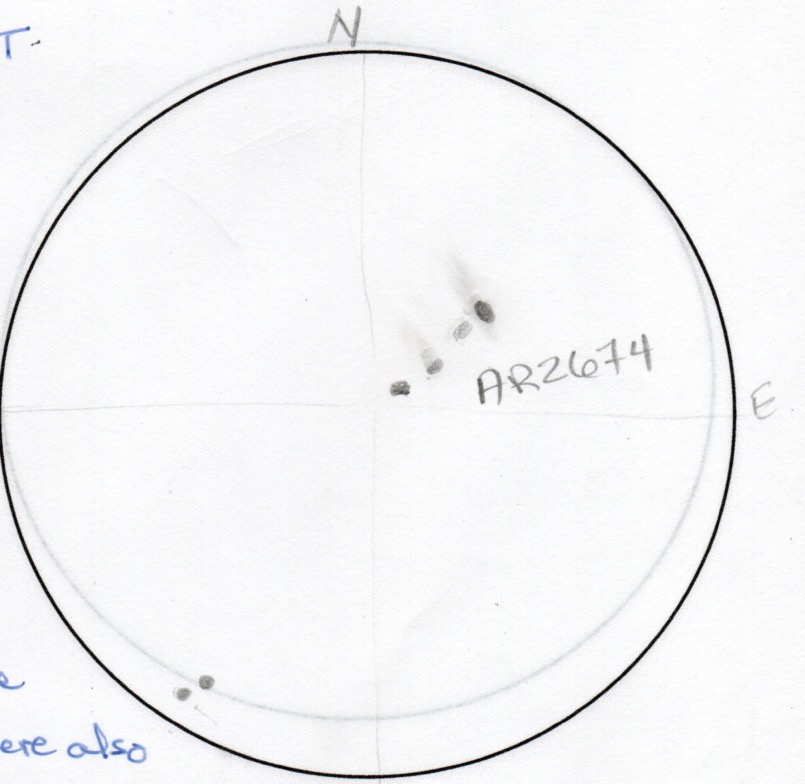 |
With the solar filters in place, the sunspots were seen. They would perfectly provide the reference points by which to observe the rate at which the moon covered the sun. Four sunspots were located in the upper right quadrant of the sun, starting near the centre and going from lower left to upper right. A fourth was noted between the first and second but it was very weak and small and not as clearly defined. Two more sunspots were also noted at about 7 o'clock on the southwestern limb.
I watched as each sunspot was hit by the limb of the Moon:
|
At 11:05 AM, I noticed the sun not quite as bright as it was earlier. The sky was getting just a bit darker and the colours of the landscape were subdued, not as vibrant as they were when the sun was full.
At 11:20 AM, I offered my binoculars to the family of 6 next to us. Each in turn had a chance to see in a much larger view how the moon was covering the sun and to see the sunspots in the southwest limb. So much fun watching their reactions, from the parents to the 6-7 year old. Also shared with a couple standing across the highway, and with a father and daughter who pulled beside us just a few minutes before totality.
At 11:40 AM, the temperature noticeably cooled, enough so that a sweater was required. Also noted that we were now being serenaded by chirping crickets. It was at this point I had total interest in what was happening around me versus recording the time frame. I did not note when the lower two sunspots were covered by the Moon nor the time and length of totality. I tried to remember Roy Bishop's description of what to expect but failed to do so in the excitement of what I was seeing.
I turned my back to the sun at one point and watched as darkness quickly approached. I likened it to being a teeny weeny little creature watching the great cape of Darth Vader billowing out as it approached and eliminating any hope of escape. I held my breath totally, enraptured as I watched it come across the field and overtake me.
What I saw next had me turning a complete 360°, and probably more than once in a couple of different directions in my attempt to decided which way I should look. A beautiful rainbow of colour appeared on the darkened horizon when the shadow overtook us. This was the one and only time I took a photo during the eclipse - a panoramic view of about 120° to 130°. Too many cars in the way to take the full 360. You can see the centre of the shadow as it rapidly travels eastward.
(Photo by Judy Black)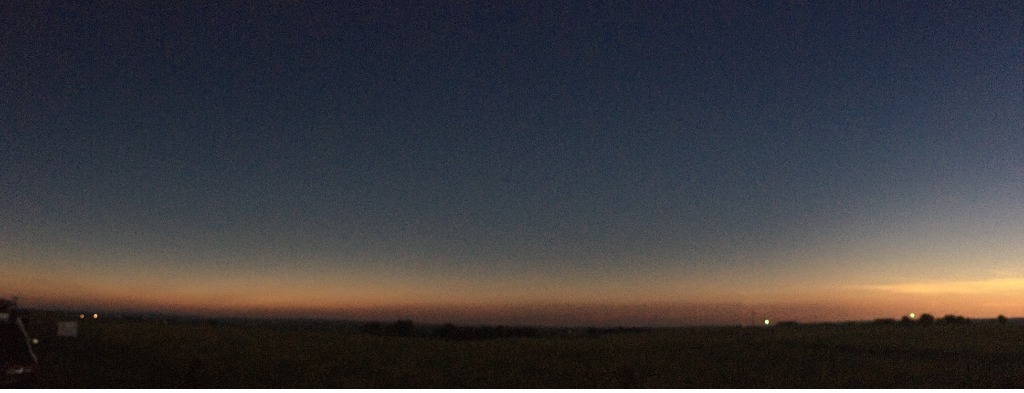
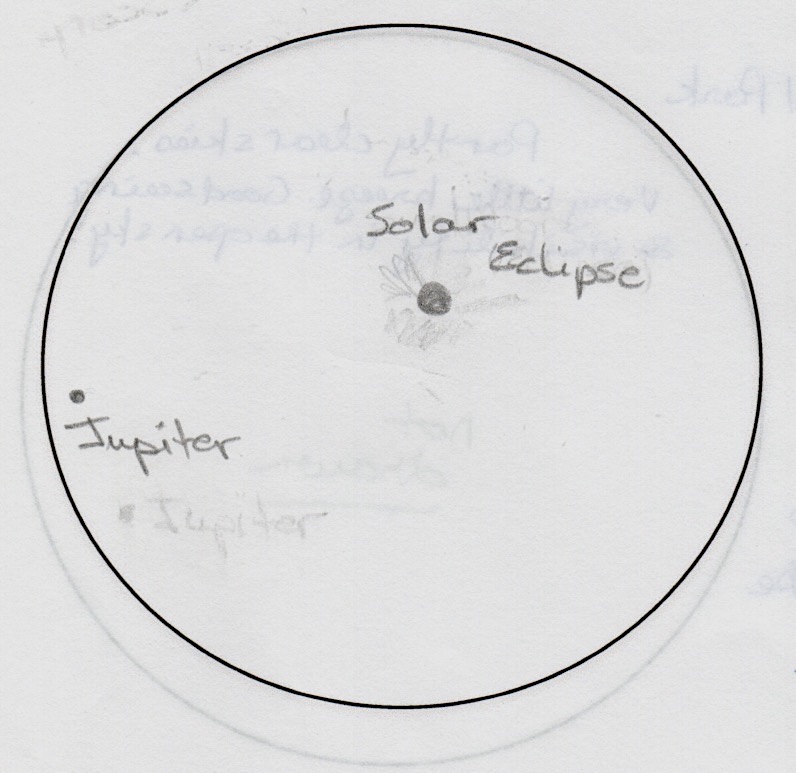 |
Totality was reached! Darkness was upon us. Regulus, Jupiter and Venus were seen but I didn't think to look closer for other planets (Mars and Mercury) and stars as suggested in articles previously read. The back orb covering the sun contrasted with the elongated translucent streams of the white solar corona that reached out into the now darkened sky. I stood there transfixed and could only think, "Oh, wow! This is really cool!" Thanks to Jerry reminding me that filters were not required at this point, I held the filter-free binoculars once more to my eyes to view the prominences at various locations around the moon's limb. Their fire engine red-pink colours were indescribably beautiful. I handed my binoculars to the daughter and father adjacent to us for them to see them as well. The corona wasn't perfectly circular; longer spikes at 12, 2 and almost 7 o'clock were visible. The corona was spectacular; the extent from its source was astonishing. |
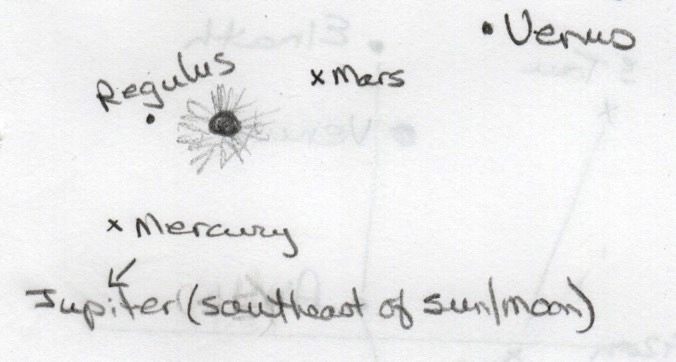 |
Once the binoculars were back in my hands and up to my eyes, Bailey's Beads appeared. Light came through the Moon's crater valleys and seemingly bent around the Moon's surface to produce a reddish glow on its surfaces, especially on the Moon's limb at 12, 1 and near 3 o'clock.
Then it happened! The "diamond"! It started as a small glimmer on the Moon's limb then shone blindingly just above the Moon's equator! Another wow. So cool! Gave me goose bumps.
According to the reference book materials, totality at our site was 2 minutes 11 seconds. It was such a short time. This wasn't long enough to truly absorb what was happening. Could a replay be granted?
It was now 11:53 AM. My wits are back (if they ever are) and I can once more record the events. Filtered binoculars and eclipse glasses were in use once more, and the air was still cool enough (for me) to require a jacket. The sun's light affected the colours around us, much like a spot light bleaches colours out; the dark greens of the field and nearby grasses had become a grey-green, shadows perhaps not as distinct. The crickets were still chirping.
The moon now began to reveal the sunspots it had earlier hid from our view:
- 12:13 PM - the first sunspot. Cars were now streaming slowly on the highway behind us; they had obviously given up once the moon had begun to reveal the sun.
- 12:17 PM - the weaker of the 4 sunspots was now visible.
- 12:23 PM - the third sunspot was revealed. Cars were now bumper-to-bumper heading towards Lingley.
- 12:27 PM - the fourth sunspot was unveiled. It was also now warm enough to remove my sweater. Colours have returned to their true colour and the sound of the chirping crickets is reduced from what they were earlier during totality.
- 1:08 PM - the first of the two sunspots in the southwest quadrant were uncovered by the moon.
At 1:14 pm, the eclipse was complete. The Moon lost contact with the southwest quadrant of the sun. Time to pack up and head back to the KOA. I now had another check mark on my Explore the Universe certificate submission! A short video of our experience can be seen at https://www.youtube.com/watch?v=k7HWur4Twp8.
End Note: Although it only took us 5 hours to arrive at Lingley from the KOA, the return trip took 11 hours. The distance between our eclipse location and the turnoff onto Interstate 80 should have taken only one hour but took 5 hours. Our heads hit our respective pillows at 1:15 AM CST, still whirring with the excitement of the day. Our trip home to Nova Scotia begins in 5 hours...